Podcast
Questions and Answers
What is the primary mechanism of action of aminoglycosides?
What is the primary mechanism of action of aminoglycosides?
- Bacteriostatic, time dependent
- Bactericidal, concentration dependent (correct)
- Bacteriostatic, concentration dependent
- Bactericidal, time dependent
What factors influence the efficacy of aminoglycosides?
What factors influence the efficacy of aminoglycosides?
- The maximum concentration (Cmax) of the drug above the MIC (correct)
- The duration of drug administration
- The renal clearance rate of the drug
- The minimum inhibitory concentration (MIC) of the bacteria
To what extent should the Cmax of aminoglycosides exceed the MIC for optimal efficacy?
To what extent should the Cmax of aminoglycosides exceed the MIC for optimal efficacy?
- 2-3 times higher than MIC
- 4-6 times higher than MIC
- Above 12 times higher than MIC
- 8-10 times higher than MIC (correct)
Which statement accurately describes the relationship between the Cmax and MIC for aminoglycosides?
Which statement accurately describes the relationship between the Cmax and MIC for aminoglycosides?
What type of drug activity is associated with aminoglycosides?
What type of drug activity is associated with aminoglycosides?
How does increasing the dosage of an antibiotic influence the post-antibiotic effect (PAE)?
How does increasing the dosage of an antibiotic influence the post-antibiotic effect (PAE)?
What is a significant benefit of using extended interval dosing of antibiotics?
What is a significant benefit of using extended interval dosing of antibiotics?
Which of the following statements is true regarding extended interval dosing?
Which of the following statements is true regarding extended interval dosing?
What effect does a single large dose have in the context of antibiotics?
What effect does a single large dose have in the context of antibiotics?
Which factor primarily contributes to extending the post-antibiotic effect (PAE)?
Which factor primarily contributes to extending the post-antibiotic effect (PAE)?
Study Notes
Aminoglycosides: Mechanism of Action
- Bactericidal action: Efficacy depends on peak drug concentration (Cmax) exceeding the minimum inhibitory concentration (MIC) by 8-10 times.
- Post-antibiotic effect (PAE): Duration increases with higher doses.
- Extended-interval dosing: Single large daily dose reduces nephrotoxicity and improves patient compliance.
- Vertigo: A potential side effect, particularly with streptomycin.
- Neuromuscular paralysis: Risk increases with high-dose, rapid infusions or concurrent use of neuromuscular blockers.
Aminoglycoside Use and Limitations
- Not recommended as monotherapy for staphylococcal infections (rapid resistance development, poor lung penetration).
- Generally ineffective against Pseudomonas and streptococci.
- Primarily used topically or orally due to toxicity limitations (e.g., neomycin unsuitable for injection).
- Topical application: Neomycin-polymyxin-bacitracin combinations treat infected skin lesions.
Studying That Suits You
Use AI to generate personalized quizzes and flashcards to suit your learning preferences.
Related Documents
Description
This quiz covers the mechanism of action, use, and limitations of aminoglycosides. Explore their bactericidal effects, dosing strategies, and potential side effects. Understand when these antibiotics should not be used alone and their applications in treatment.




